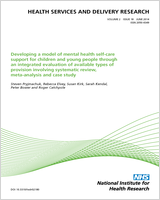Included under terms of UK Non-commercial Government License.
NCBI Bookshelf. A service of the National Library of Medicine, National Institutes of Health.
Littlewood E, Ali S, Dyson L, et al. Identifying perinatal depression with case-finding instruments: a mixed-methods study (BaBY PaNDA – Born and Bred in Yorkshire PeriNatal Depression Diagnostic Accuracy). Southampton (UK): NIHR Journals Library; 2018 Feb. (Health Services and Delivery Research, No. 6.6.)

Identifying perinatal depression with case-finding instruments: a mixed-methods study (BaBY PaNDA – Born and Bred in Yorkshire PeriNatal Depression Diagnostic Accuracy).
Show detailsThe overall purpose of this research was to determine the diagnostic accuracy, acceptability and cost-effectiveness of case-finding questions to identify perinatal depression in women. The objectives of the study were as follows.
- Instrument validation: to determine the diagnostic accuracy of the Whooley questions and the EPDS against a diagnostic reference standard for the identification of depression during pregnancy (around 20 weeks) and the early postnatal period (around 3–4 months after birth).
- Longitudinal assessment: to assess the temporal stability of positive and negative depression screens between pregnancy and the early postnatal period, and to ascertain whether or not there is an optimal time to screen for perinatal depression.
- Assessment of comorbidity: to investigate the coexistence of depressive symptoms alongside other common mental health problems during the perinatal period.
- Evaluation of Acceptability: to determine the acceptability of the Whooley questions and the EPDS to expectant and new mothers and to HPs, and to determine the potential implications for the care pathway during the perinatal period.
- Estimates of cost-effectiveness: to assess the cost-effectiveness of the Whooley questions and the EPDS as case-finding strategies for the identification of perinatal depression.
- Research objectives - Identifying perinatal depression with case-finding instrum...Research objectives - Identifying perinatal depression with case-finding instruments: a mixed-methods study (BaBY PaNDA – Born and Bred in Yorkshire PeriNatal Depression Diagnostic Accuracy)
Your browsing activity is empty.
Activity recording is turned off.
See more...